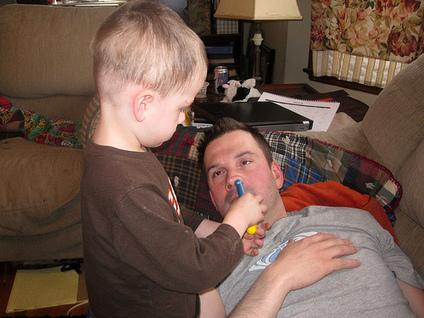Do You Know How to Find Happiness In the Midst of Intensely Negative Emotions
I’ve got a problem.
I cannot quite put my finger on where it comes from—it may be a masculine thing, it may be from attending lots of workshops or an unusual interest in reading self-help books, or it may be the result of being raised by two therapists. It could simply be that I care a lot about people and I do not like to see them suffer.
Whatever the cause, the problem is this: I want to fix people’s problems.
I know, you’re probably thinking, “That’s not a problem Jordan.” Well you’re right… kind of.
Don’t Fix it if it Aint Broken
The problem lies not in wanting to fix people’s problems, but in the fact that trying to fix usually does not work. Or at least it is not nearly as effective as simply being with someone, loving them exactly as they are.
If I think someone needs something to be fixed, I am very subtly judging their emotional state and saying that in this moment they are not okay exactly as they are.
For example, if Sally is crying and I want her to be happy, I am placing a subtle judgement on her sadness, pushing it away, and therefore encouraging her to repress her emotions instead of investigate them more fully. And by judging her sadness and secretly thinking it is “not okay,” I am ironically denying her the love that motivates me to care about her in the first place.
How Care Becomes Judgement
Sally: “Boohooohohooo.”
Jordan: “It’s all going to be okay Sally, don’t worry, it’s going to be fine.” ← Note that I am usually lying—I have no idea if life is all going to be okay anytime soon for Sally. For all I know she’ll be stuck in depression for a long time (or a meteor will wipe out all life on Earth). And in responding this way to her current sadness, the underlying message is “You’re not okay now, because it’s not okay to be sad.”
In practice, loving someone exactly as they are must also include loving myself exactly as I am. Just as I do not judge the other person’s negative emotions, I do not judge my own. Just as I welcome their anger or judgement, I welcome my own. I honestly disclose what arises in me while maintaining connected to the other person.
How Judgement Becomes Care
So for example if I truly do not want Sally to be sad, I disclose exactly how her tears affect me. Not as a way to get her to stop crying (she’s likely to cry even harder), but as a commitment to care, through authenticity and staying present in the moment with her. For example:
Sally: “Boohoohohooo.”
Jordan: “I really do not want you to cry.” ← Note that I haven’t really owned my own experience yet because I haven’t gotten in touch with the emotion underlying the desire. In this case is likely to be sadness that comes from a deep care, perhaps even a sense of powerlessness and fear.
Sally: “But I’m so sad… waaaa.”
Jordan: “I am so sad being here with you. I care about you so much.”
Sally: “I know. waaaaaaa.”
Jordan: “I just feel powerless to help you and I really want to help you.”
By being true to my own experience I am no longer imposing my point of view upon Sally. She knows that I feel powerless and I am uncomfortable because of my own feeling of impotence, not because of her. The subtext is that she has permission to be who she is in the moment. Plus, she is also now aware of how much I care about her.
The Paradox of Not Fixing My Own Problem
Knowing this tendency I have, what do I do? Applying the same logic internally, if I think I need to stop trying to fix people, then I am not fully accepting the truth of who I am in this moment. I am likely never to resolve my problem. Yet, it is also true that in this moment I want to overcome this issue. How can I hold both of these seemingly contradictory truths?
I have to let go of the assumption that two contradictory ideas cannot coexist at the same time. Beyond relativism, where I can be both tall and short from different perspectives, it is quite possible to be both happy and sad at the same time—from the same perspective.
Easier said than done. We are socialized to draw distinctions and create absolute boundaries because they can be extremely useful. Yet when it comes to the complexity of the self system, psychology, and human emotion, a more encompassing way of understanding is necessary to be more accurate and caring.
So once I let myself experience both the desire to fix my own problem (of wanting to fix other’s problems), and the desire to not fix my own problem (partly in order to fix it), I relax into that paradox.
And whenever I feel myself relaxing into the paradox in order to resolve it, I notice that and laugh. If I notice myself using that relaxation as a technique to fix myself, I just stay with it, noticing the feelings of disappointment and frustration, of wonder and excitement.
True Happiness
Instead of needing my problem to resolve, I let myself be complex, tense, divided. In my brokenness I find that I never needed to be fixed. And in that realization, I stumble upon true happiness.

